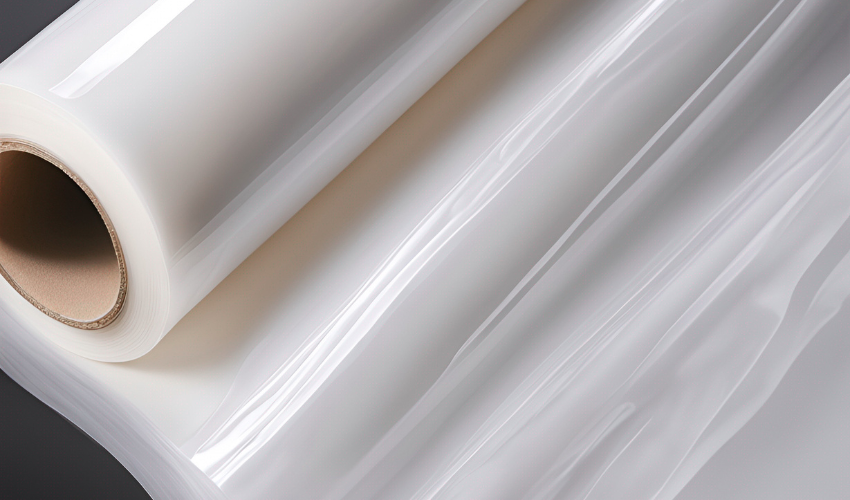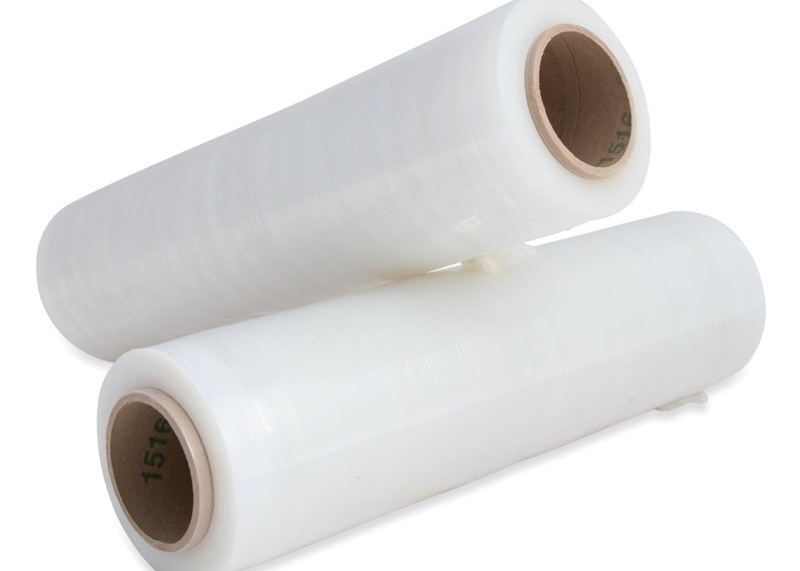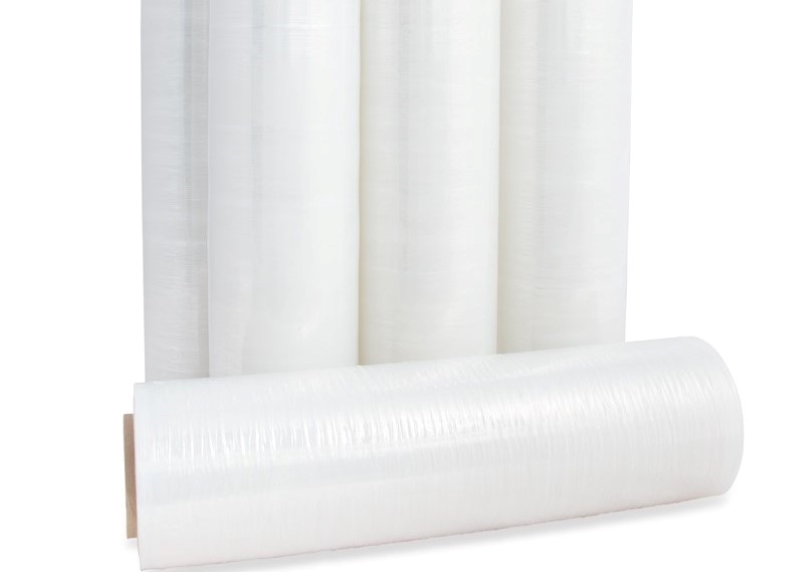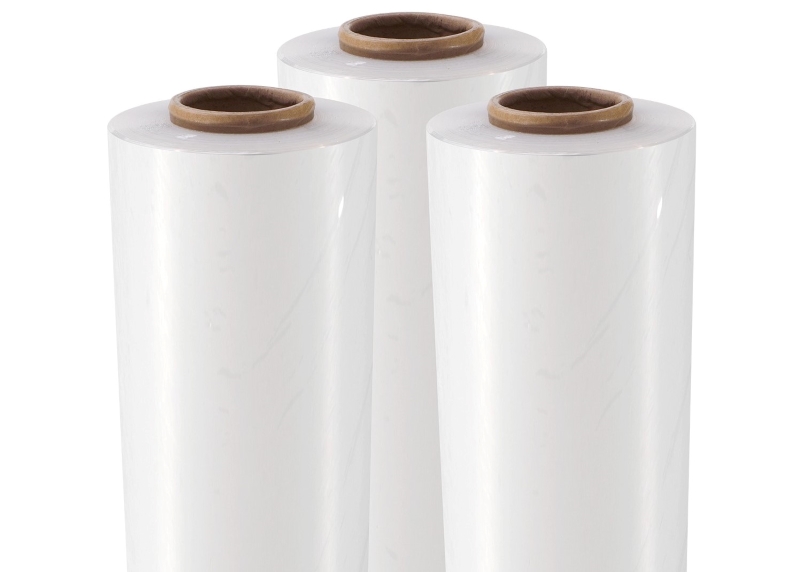
In the world of packaging and shipping, stretch wrap plays a crucial role in securing products and preventing damage during transit. This versatile material not only keeps items tightly bound but also protects them from dust, moisture, and other environmental factors. One essential aspect that often goes overlooked is stretch wrap length. Understanding the significance of stretch wrap length is vital for businesses seeking optimal protection for their goods. The right length ensures that each pallet or item is adequately wrapped, maximizing security and minimizing waste. By carefully selecting the appropriate stretch wrap length, companies can enhance their packaging efficiency and ultimately improve their shipping outcomes. Choose a stretch wrap length of 1,500 ft for manual use, 5,000-9,000 ft for machines, and 20″ x 5000′ cast film for stable transport.
Stretch wrap, also known as stretch film, is a highly elastic material that is widely used in packaging and shipping. Made primarily from linear low-density polyethylene (LLDPE), stretch wrap is designed to cling tightly to products and secure them for storage or transportation. Its elasticity allows it to be stretched to several times its original length, creating a strong, protective layer around various items. This ability to stretch without tearing or breaking makes it an essential tool in the logistics and supply chain industries.

Stretch wrap is typically produced in large rolls and comes in various thicknesses, widths, and lengths, catering to different packaging needs. It can be applied manually or with machines, depending on the volume of goods being wrapped. The material is transparent or colored, allowing for easy visibility of the items underneath while also providing options for color coding or branding. The primary function of stretch wrap is to hold items together and prevent them from shifting or becoming damaged during handling and transportation.
Stretch film can be categorized into two main types: cast stretch film and blown stretch film. Cast stretch film is known for its clarity and ease of use, making it ideal for hand applications and for wrapping products that require visibility, such as shipping boxes and retail items. On the other hand, blown stretch film, there are two main types included blown machine stretch film and blown hand stretch film, both offer greater strength and resistance to punctures, making it suitable for heavier loads and more demanding environments. The elongation with stretch wrap refers to its ability to stretch significantly, enhancing its effectiveness in securing items tightly without tearing.
Stretch wrap length refers to the total linear measurement of stretch film wound onto a roll, typically expressed in feet or meters. It determines how much film is available for wrapping items and plays a crucial role in selecting the right stretch film for various applications. Whether you are manually wrapping smaller packages or using a machine to secure large pallets, the length of the stretch wrap ensures sufficient material to protect and stabilize loads during transport or storage.
Manual stretch wrap rolls usually range from 1,000 to 1,500 feet, while machine rolls, designed for high-volume operations, can extend from 5,000 to 9,000 feet or more. Longer rolls are particularly advantageous in reducing downtime and increasing efficiency in industrial or commercial settings. Choosing the correct stretch wrap length depends on factors like the size and weight of the load, wrapping technique, and the type of film being used, ensuring both cost-effectiveness and optimal load security.
Stretch wrap is an essential tool in packaging and shipping due to its elasticity, versatility, and protective qualities. Understanding the right type and length of stretch wrap is vital for optimizing packaging solutions and ensuring the safety of goods.
Improving Shipping Outcomes
Palletizing Goods for Shipping
Protecting Inventory in Storage
Proper length is crucial for adequate coverage and security of loads.
Businesses should consider product dimensions and specific storage/shipping requirements when selecting stretch wrap.
Using the right length minimizes waste and enhances wrapping efficiency, leading to cost savings and improved operational productivity.
The stretch wrap length of rolls is a crucial factor in the packaging and shipping processes. Understanding its importance can significantly enhance operational efficiency, reduce costs, and ensure the safe transport of goods.
The length of stretch wrap rolls directly affects how effectively the material can be used in various applications. Longer rolls, typically measuring 5,000 feet or more, allow for extended usage without frequent replacements. This is particularly beneficial in high-volume environments, such as warehouses or distribution centers, where the speed of wrapping goods can influence overall productivity.
When using shorter rolls, workers may need to stop and change out rolls frequently, which can lead to downtime and inefficiencies. In contrast, utilizing longer rolls minimizes these interruptions, enabling workers to wrap pallets and products continuously. This consistency not only improves workflow but also reduces labor costs, as fewer roll changes mean less time spent on tasks that do not directly contribute to packaging.
| Aspect | Details |
|---|---|
| Direct Correlation | The stretch wrap length directly affects the number of pallets or items that can be secured in a given timeframe. |
| Considerations for Selection | Businesses must consider the dimensions and weight of products when selecting the appropriate length. |
| Benefits of Longer Rolls | Allow for more complete wraps around each pallet. |
| Efficiency in Wrapping | Longer rolls enable secure wrapping of multiple pallets in fewer passes, conserving stretch film and enhancing load stability. |
| Impact on Stability | A well-wrapped pallet minimizes the risk of shifting or toppling over, reducing damage during transit. |
| Inventory Management | Calculating the number of pallets wrapped with different roll lengths aids in inventory management and cost forecasting. |
When selecting stretch wrap for packaging, understanding the specifications is essential for ensuring the material meets operational needs. Key specifications include gauge, stretchability, and width, all of which play a critical role in determining the effectiveness of the wrap and its relationship to stretch wrap length.
The gauge of stretch wrap refers to its thickness, typically measured in mils or gauge units. A higher gauge indicates a thicker film, which generally offers greater durability and strength. Common gauges range from 60 to 90, with 80 gauge being the industry standard for general-purpose applications. Thicker films are more resistant to tears and punctures, making them suitable for heavy loads and rough handling environments.
The relationship between gauge and stretch wrap length is significant; thicker wraps may require more careful handling and may not stretch as easily as thinner films. Therefore, while longer rolls of thicker wrap can provide security and stability for larger loads, they may also necessitate more effort in application, especially if using manual techniques.
Stretchability is a critical characteristic of stretch wrap, indicating how much the film can elongate before breaking. High performance stretch films can stretch anywhere from 150% to 300% of their original length. This property allows the film to conform to the shape of the wrapped items, providing a tight and secure hold.
When considering stretch wrap length, it is important to select a film with the appropriate stretchability for the specific application. For instance, a highly stretchable film is advantageous for irregularly shaped or heavy items, as it can wrap around the contours and secure the load tightly. This enhanced stretchability can result in using less film overall, as fewer wraps may be needed to achieve optimal security.
The width of stretch wrap rolls also affects their usability and application. Common widths range from 12 inches to 30 inches, with wider films often used for larger pallets or bulk items. A wider roll allows for a greater surface area to be covered in a single wrap, which can increase efficiency during the packaging process.
The choice of width, in conjunction with stretch wrap length, is crucial for maximizing the effectiveness of the film. For example, when wrapping larger pallets, a wider film may be more effective in securing the load with fewer passes, thereby saving time and reducing material waste. Conversely, narrower rolls are often more suitable for smaller items, allowing for precise wrapping without excess material.
Understanding the specifications of stretch film, including gauge, stretchability, and width, is vital for selecting the right film for packaging needs. These specifications directly relate to stretch wrap length, impacting the film’s effectiveness in securing loads. By considering these factors, businesses can optimize their packaging processes, ensuring products are well-protected during storage and transportation while maximizing efficiency and cost-effectiveness.
Selecting the appropriate stretch wrap length is crucial for ensuring efficient and effective packaging. The right length not only protects your products during storage and transit but also minimizes waste and maximizes cost-efficiency.

Here are some tips to guide you in choosing the ideal stretch wrap length based on specific factors:
When determining the right stretch wrap length, consider the size and weight of the items you plan to package. Larger and heavier items require more wrap to secure them properly. For instance, if you are wrapping pallets of heavy machinery or bulky furniture, you might need a longer roll to ensure multiple layers of wrap can securely hold the load. In contrast, lighter and smaller items may require less wrap, allowing for shorter rolls to be effective.
The quantity of items being shipped also significantly impacts the selection of stretch wrap length. If you are shipping multiple items in a single shipment, using a longer roll allows you to wrap several items efficiently without constantly changing rolls. This is especially useful in bulk packaging scenarios where you need to quickly secure numerous products on a single pallet. Conversely, if you’re only wrapping a few small items, a shorter roll may suffice, reducing excess material and costs.
The wrapping technique employed also affects the choice of stretch wrap length. Different methods, such as spiral wrapping or the double-wrapping technique, may require varying lengths of film. For example, the spiral technique typically involves overlapping the film as you wrap, which may use more material and therefore require a longer roll to accommodate this method. Understanding your preferred technique is essential to ensure that you have adequate stretch wrap length for the task at hand.
Choosing the right stretch wrap length involves considering the size and weight of the items, the number of items per shipment, and the wrapping technique used. By evaluating these factors, you can select a stretch wrap that not only secures your products effectively but also optimizes your packaging process, reducing waste and improving efficiency. Properly assessing your needs ensures that you have the right materials on hand to meet your shipping and storage requirements.
When it comes to stretch wrap length, several misconceptions can lead to ineffective packaging practices. Understanding these myths is crucial for making informed decisions about which stretch wrap to use. Here, we debunk some common myths and clarify the importance of selecting the appropriate length for specific applications.
Standard elongation for stretch wrap typically ranges from 100% to 400%, depending on the type and purpose of the film. This elongation refers to the ability of the wrap to stretch and conform to the items being secured, providing a tight hold without compromising the film’s integrity. Adequate elongation is essential for ensuring that the wrap can secure various shapes and sizes effectively, enhancing load stability during transport.
One of the most prevalent misconceptions is that longer rolls of stretch wrap are inherently better. While longer rolls can be more convenient for high-volume operations, they are not always the best choice for every situation. The effectiveness of the wrap depends on the specific items being packaged. For smaller items or lighter loads, a shorter roll might be more practical and economical. Using excessively long rolls for minor wrapping tasks can lead to unnecessary waste and added costs.
Another myth is that the thickness of stretch wrap is the only factor that matters when selecting a product. While gauge and thickness are indeed important for strength and protection, stretch wrap length plays a vital role in the overall effectiveness of the packaging. A thicker film may provide better puncture resistance, but if the length is insufficient for the size and weight of the items, the wrap may not secure the load properly. Thus, both length and thickness must be considered together to achieve optimal packaging performance.
Many believe that a single stretch wrap length can be suitable for all applications. This is far from the truth. Different items require different wrapping techniques, which can influence the amount of stretch wrap needed. For instance, when wrapping pallets, the length of the film must accommodate the height and width of the load while considering the overlap for secure wrapping. Therefore, tailoring the choice of stretch wrap length to the specific application is crucial for effective protection.
Some people underestimate the impact of stretch wrap length on overall efficiency. Using the wrong length can lead to frequent roll changes, increasing the time and labor required for packaging tasks. This inefficiency can be particularly detrimental in high-volume operations where speed is essential. By selecting the appropriate length from the outset, businesses can streamline their packaging process, ultimately saving time and reducing labor costs.
It’s important to recognize that longer rolls are not always superior, thickness is not the only consideration, and that one size does not fit all. Additionally, the length of stretch wrap directly influences efficiency. By selecting the right length tailored to specific applications, businesses can enhance their packaging effectiveness, reduce waste, and improve overall operational efficiency.
Stretch wrap length plays a crucial role in ensuring effective and efficient wrapping for various applications, from securing small packages to stabilizing large pallets. Choosing the correct stretch wrap length depends on factors like the type of wrapping process, the size and weight of the load, and the frequency of use. Manual stretch wrap and machine stretch wrap are the two primary types, each with distinct lengths designed to suit specific needs. In this guide, we’ll explore the common lengths of manual and machine stretch wrap, highlight their differences, and provide insights to help you make the best choice for your wrapping requirements. Understanding these variations can enhance your wrapping efficiency, reduce costs, and ensure the stability of your shipments.

Manual stretch wrap rolls are designed for smaller-scale operations and hand application. These rolls typically range from 1,000 to 1,500 feet in length. They are ideal for businesses with lower wrapping volumes, providing portability and ease of use for securing smaller loads or shipments. The shorter length of manual stretch wrap ensures that the rolls are lightweight and manageable, making them a practical choice for manual labor.
Machine stretch wrap rolls, on the other hand, are designed for high-volume and industrial use. These rolls are significantly longer, commonly ranging from 5,000 to 9,000 feet. Their extended length reduces the need for frequent roll changes, improving efficiency in operations that involve wrapping larger loads or multiple pallets. The longer length is particularly suited for automated or semi-automated stretch wrap machines, ensuring consistent application across heavy-duty tasks.
While both manual and machine stretch wrap serve the same purpose, their lengths reflect their intended uses. Manual rolls are shorter to allow easier handling by workers, whereas machine rolls are longer to optimize efficiency in high-demand environments. Additionally, manual wraps are better suited for smaller or irregularly shaped items, while machine wraps provide uniform tension and coverage for larger and heavier loads. The difference in length also impacts cost-effectiveness: machine rolls, though initially more expensive, can wrap more loads per roll compared to manual wraps.
By understanding the differences in stretch wrap length, businesses can select the most appropriate type to meet their wrapping needs, balancing efficiency, cost, and ease of use.
To properly measure stretch wraps, there are several aspects to consider, including thickness, width, and length. The thickness of stretch wrap, usually measured in gauges (with 1 gauge approximately equal to 0.254 microns), indicates the strength and durability of the wrap. Common measurements are 60, 70, 80, and 90 gauges. The width is often measured in inches and typically ranges from 10 inches to 20 inches or more, depending on the application. The length refers to the total stretchable length of the wrap on a roll, and it is usually measured in feet. Knowing these dimensions is critical for selecting the right wrap for specific packaging needs, ensuring that items are securely wrapped and protected during transportation and storage.
The primary difference between 60 gauge and 80 gauge stretch wrap is their thickness and therefore their strength and application. A 60 gauge stretch wrap is generally thinner and less durable than an 80 gauge wrap. It is more suitable for lighter applications such as wrapping individual items or small boxes. Its lighter nature makes it easier to handle and more economical for less demanding tasks. On the other hand, an 80 gauge stretch wrap provides greater strength and resistance to punctures and tears, making it ideal for securing heavier loads or items with sharper edges. The thicker film also ensures better protection against dirt, moisture, and other external elements, making it well-suited for industrial or heavier commercial uses. Understanding these differences can help users select the appropriate stretch wrap to meet the specific demands of their package or shipment.
The core size of stretch film refers to the diameter of the inner roll around which the stretch film is wound. Common core sizes are often 2 inches or 3 inches, catering to different dispenser types and handling preferences. The core size plays an important role in how the film can be applied; a smaller core might fit standard manual dispensers, making it more manageable for individual packing tasks. In contrast, a larger core may require a stationary dispenser, which can facilitate faster and more efficient wrapping in a commercial setting. Choosing the right core size depends on the equipment available and the specific needs of the wrapping process.
The longevity of stretch wrap primarily depends on the storage conditions and the quality of the film used. Generally, high-quality stretch wrap stored in a dry, cool, and UV-protected environment can last several years without significant degradation in performance. Exposure to extreme temperatures, direct sunlight, or chemical vapors can accelerate the breakdown of the stretch film, reducing its stickiness and elasticity. It’s essential to store stretch wrap in optimal conditions to maintain its effectiveness and ensure that it provides reliable protection when needed. Additionally, users should be aware of the manufacturer’s guidelines on shelf life and best practices for storage to maximize the durability and performance of the stretch wrap.
Stretch film typically comes in standard sizes designed to suit various applications. The most common widths are 12 inches, 18 inches, and 20 inches, with lengths ranging from 1,000 feet to 5,000 feet depending on the roll type. Hand stretch film rolls are usually 1,000 to 1,500 feet in length, while machine stretch films can reach up to 5,000 feet or more for high-volume operations. The film’s thickness, measured in microns or gauge, also affects its standard size. Common gauges include 60 to 120 gauge, with lighter gauges used for lighter loads and thicker ones for heavier pallets. Stretch film width and thickness are standardized to provide consistent performance across industries, whether for wrapping pallets, bundling smaller items, or securing loads for transport. However, specialty films like extended core, pre-stretched, or colored stretch wraps may have slightly different sizes to meet unique needs.
Stretch film is measured in three key dimensions: width, thickness, and length. The width is the distance across the roll, typically between 12 to 20 inches for hand wraps and up to 80 inches for machine wraps. Thickness is measured in gauge (U.S.) or microns (metric), with 1 gauge equal to 0.254 microns. Length refers to how much film is wound onto the roll, usually listed in feet or meters. Stretch film is also evaluated for its stretch percentage, the degree to which it can elongate during application, commonly ranging between 100% to 300%. For example, a film with a 200% stretch can extend 2 additional feet for every original foot. When purchasing stretch film, the length is often a deciding factor for cost-effectiveness, as longer rolls reduce the need for frequent replacement during wrapping.
The usability of stretch wrap largely depends on the conditions of its application and storage. When stored in a cool, dry environment away from direct sunlight, stretch wrap can last up to 18 to 24 months without significant degradation. Once applied, the longevity of the wrap depends on the load’s weight, environmental exposure, and how well the wrap was secured. For indoor storage, a properly applied stretch wrap can protect items for several months, but outdoor exposure to sunlight, moisture, and temperature changes can shorten its effectiveness due to UV degradation or weakening elasticity. Stretch wraps with UV inhibitors are recommended for outdoor use to extend their lifespan. Over time, even unused rolls may become brittle if not stored properly, so regular inventory rotation is essential to ensure optimal performance.
Stretch in stretch wrap is measured by its elongation capacity or the percentage of stretch it can achieve relative to its original length. Manufacturers determine this by stretching a sample under controlled conditions until it reaches its maximum elongation point. For example, a stretch film rated at 200% stretch means that 1 foot of film can stretch to 3 feet total. Stretch is a critical factor in load stability, as films with higher elongation can secure heavier or irregularly shaped loads. Stretch measurements also include the film’s resilience (ability to return to its original form) and tensile strength (ability to withstand force without breaking). While higher-stretch films offer better coverage and cost-effectiveness, they should be matched with the load’s requirements to avoid over-stretching, which could lead to reduced holding power.
The appropriate gauge for stretch wrap depends on the weight and dimensions of the load. For lightweight loads (up to 1,500 lbs), a 60–80 gauge film is sufficient. For medium-weight loads (1,500–2,000 lbs), an 80–120 gauge film is recommended, providing greater strength and puncture resistance. Heavy-duty loads (2,000+ lbs) require films in the 120–150 gauge range. Modern pre-stretched films offer high strength at lower gauges, making them cost-effective for lighter to medium loads. Gauge selection also varies based on application type: bundling smaller items, securing pallets, or wrapping irregular loads may require different thicknesses. It’s essential to consider environmental factors, such as sharp edges or outdoor storage, which may demand thicker gauges or specialty films with additional durability features, like UV resistance or enhanced cling properties.

My name is James Thompson, and I’m the editor of this website dedicated to Stretch Film, Pallet Wrap, and Stretch Wrap products.
My passion for packaging began when I noticed the challenges companies face in securing their products efficiently for transportation and storage. This inspired me to delve deep into the world of stretch films and pallet wraps, exploring the latest technologies and best practices.
I aim to provide valuable insights, practical tips, and up-to-date industry trends to assist you in making informed decisions. Whether you’re a small business owner or part of a large corporation, my goal is to support you in optimizing your operations and ensuring your products reach their destination safely.
Thank you for visiting, and I look forward to accompanying you on your journey toward better packaging solutions.
Comments are closed